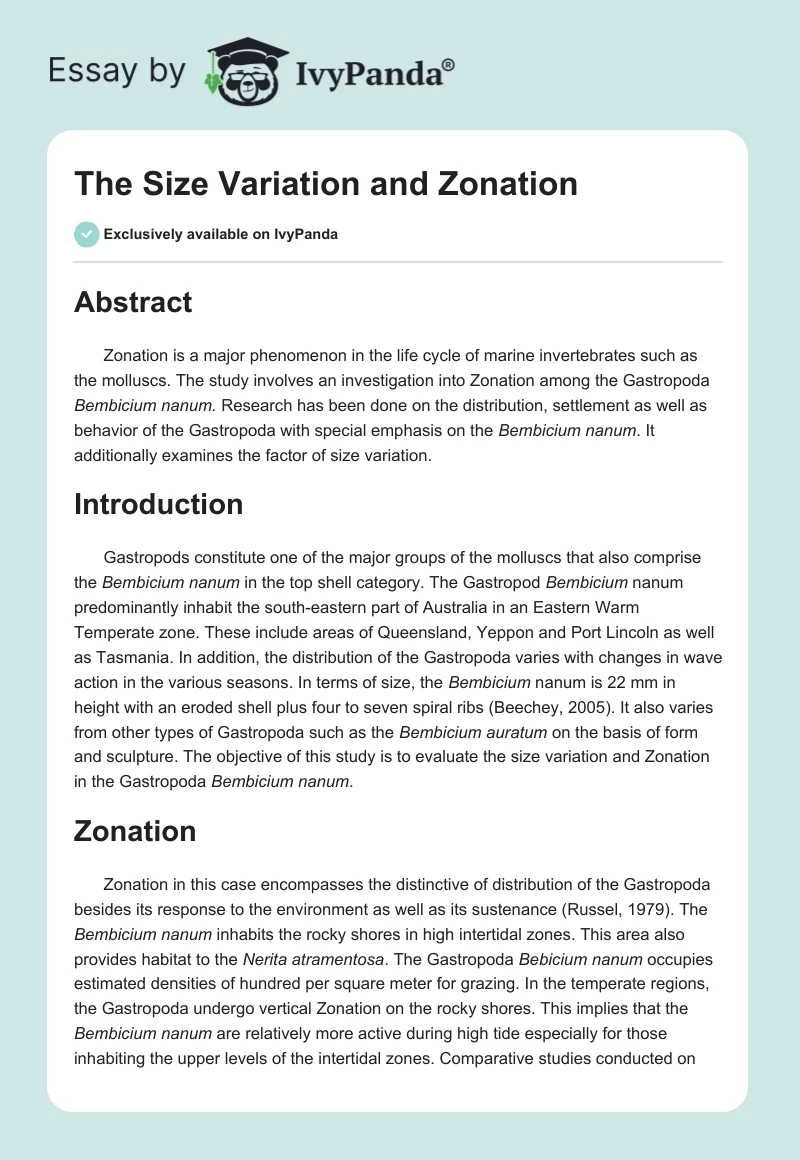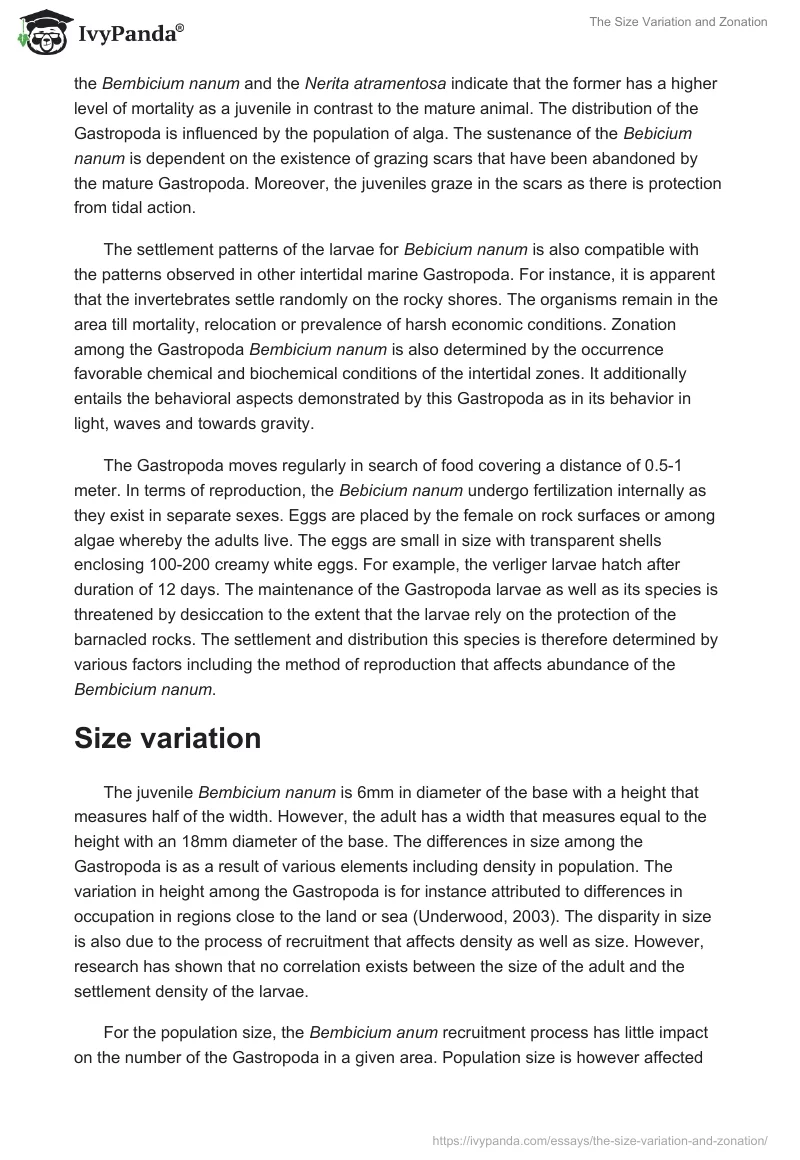Abstract
Zonation is a major phenomenon in the life cycle of marine invertebrates such as the molluscs. The study involves an investigation into Zonation among the Gastropoda Bembicium nanum. Research has been done on the distribution, settlement as well as behavior of the Gastropoda with special emphasis on the Bembicium nanum. It additionally examines the factor of size variation.
Introduction
Gastropods constitute one of the major groups of the molluscs that also comprise the Bembicium nanum in the top shell category. The Gastropod Bembicium nanum predominantly inhabit the south-eastern part of Australia in an Eastern Warm Temperate zone. These include areas of Queensland, Yeppon and Port Lincoln as well as Tasmania. In addition, the distribution of the Gastropoda varies with changes in wave action in the various seasons. In terms of size, the Bembicium nanum is 22 mm in height with an eroded shell plus four to seven spiral ribs (Beechey, 2005). It also varies from other types of Gastropoda such as the Bembicium auratum on the basis of form and sculpture. The objective of this study is to evaluate the size variation and Zonation in the Gastropoda Bembicium nanum.
Zonation
Zonation in this case encompasses the distinctive of distribution of the Gastropoda besides its response to the environment as well as its sustenance (Russel, 1979). The Bembicium nanum inhabits the rocky shores in high intertidal zones. This area also provides habitat to the Nerita atramentosa. The Gastropoda Bebicium nanum occupies estimated densities of hundred per square meter for grazing. In the temperate regions, the Gastropoda undergo vertical Zonation on the rocky shores. This implies that the Bembicium nanum are relatively more active during high tide especially for those inhabiting the upper levels of the intertidal zones. Comparative studies conducted on the Bembicium nanum and the Nerita atramentosa indicate that the former has a higher level of mortality as a juvenile in contrast to the mature animal. The distribution of the Gastropoda is influenced by the population of alga. The sustenance of the Bebicium nanum is dependent on the existence of grazing scars that have been abandoned by the mature Gastropoda. Moreover, the juveniles graze in the scars as there is protection from tidal action.
The settlement patterns of the larvae for Bebicium nanum is also compatible with the patterns observed in other intertidal marine Gastropoda. For instance, it is apparent that the invertebrates settle randomly on the rocky shores. The organisms remain in the area till mortality, relocation or prevalence of harsh economic conditions. Zonation among the Gastropoda Bembicium nanum is also determined by the occurrence favorable chemical and biochemical conditions of the intertidal zones. It additionally entails the behavioral aspects demonstrated by this Gastropoda as in its behavior in light, waves and towards gravity.
The Gastropoda moves regularly in search of food covering a distance of 0.5-1 meter. In terms of reproduction, the Bebicium nanum undergo fertilization internally as they exist in separate sexes. Eggs are placed by the female on rock surfaces or among algae whereby the adults live. The eggs are small in size with transparent shells enclosing 100-200 creamy white eggs. For example, the verliger larvae hatch after duration of 12 days. The maintenance of the Gastropoda larvae as well as its species is threatened by desiccation to the extent that the larvae rely on the protection of the barnacled rocks. The settlement and distribution this species is therefore determined by various factors including the method of reproduction that affects abundance of the Bembicium nanum.
Size variation
The juvenile Bembicium nanum is 6mm in diameter of the base with a height that measures half of the width. However, the adult has a width that measures equal to the height with an 18mm diameter of the base. The differences in size among the Gastropoda is as a result of various elements including density in population. The variation in height among the Gastropoda is for instance attributed to differences in occupation in regions close to the land or sea (Underwood, 2003). The disparity in size is also due to the process of recruitment that affects density as well as size. However, research has shown that no correlation exists between the size of the adult and the settlement density of the larvae.
For the population size, the Bembicium anum recruitment process has little impact on the number of the Gastropoda in a given area. Population size is however affected by competition between the Gastropoda and other forms of species that share habitat or food type. For example, studies carried out in 2004 in sheltered regions established that population size was four times in juvenile Gastropoda as compared to adult or the mature Bembicium anum. In experiments done to compare the sizes of the bembecium anum with others such as the nerita atramentosa, results showed that population size is also determined by wave action besides topography(Underwood, Landing on one’s foot: small-scale topographic features of habitat and the dispersion of juvenileintertidal gastropods, 2004). The morphology of the species also brings about variation in size coupled with the aspect of reproduction factors that differ intra-specifically.
Conclusion
Zonation of the Bembicium nanum has been noted to entail the behavioral mechanism and maintenance the Gastropoda as well as its response to aspects of its local environment. It is clear that the Gastropoda is common along rocky shores whereby vertical Zonation takes place. In addition, it is clear that the Gastropoda varies in size on the basis of maturity besides population. The study has found that that the juvenile Bembicium nanum differs relatively from the mature organism.
References
Beechey, D. (2005). Bembicuim nanum.
Russel, F. S. (1979). Advances in Marine Biology, Volume 16. London: Academic Press.
Underwood, A. J. (2003). Intertidal Zonation of prosobranch gastropods : Analysis of densities of four co-existing species. Journal of Experimental Marine Biology and Ecology , 19 (197-216).
Underwood, A. J. (2004). Landing on one’s foot: small-scale topographic features of habitat and the dispersion of juvenileintertidal gastropods. MARINE ECOLOGY PROGRESS SERIES , 268, 173-182.


